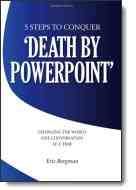Setting yourself and your marketing presentations apart using five steps and one change in behaviour
According to some estimates, between 30 and 40 million PowerPoint presentations are created each day. If each presentation averages 35 slides, simple math tells us that enough slides are produced to provide every man, woman and child on the planet with a new slide each week.
But of those millions of presentations delivered each day, how many are effective? How many provide information of value to the audience, making the presentation a good use of their time?
The state of the presentation art
During the past 20 years at my workshops and seminars, I have asked more than twenty thousand people to raise their hands to each of the following statements in turn:
- Raise your hand if most of the business presentations you’ve attended in the past few years have made extensive use of visual aids.
- Raise your hand again if you can say that 51 per or more of the presentations you attended in that period were a good use of your time.
Virtually every hand has gone up to the first statement. Everyone knows that modern presentations are accompanied by slides—either projected, printed or both.
Response to the second statement has been interesting. About six to eight per cent of people put their hands up. I’ve presented to rooms of 200 people in which less than ten people put up their hands to say: “Yes, more than half of the presentations I’ve attended have been a good use of my time.”
The simple message here is that the vast majority of presenters use visual aids when attempting to communicate with their fellow human beings. We know that. But the vast majority of those visuals are ultimately wasting people’s time.
How can you improve your presentations?
As a marketer, how do you set yourself apart from the millions of others produced each day? How do you ensure that your next presentation is both memorable and valuable?
5 Steps & One Change in Behaviour
All it takes is five steps and one change in behaviour. The five steps are the easy part:
- Put the audience first
- Structure the conversation
- Minimize visual aids
- Convey your message & personality
- Answer questions throughout
Changing Your Behaviour
Unfortunately, for most people, the one behaviour that needs changing is the most difficult thing possible to change. But let’s be clear. If you wish to bring value to audiences and influence others through your marketing presentations, you simply cannot and must not develop your presentation content while sitting at PowerPoint (or Keynote or SlideRocket or Prezi, or any other slideware program in existence or yet to be invented).
When you use slideware to develop content, you spend more time fiddling with slides than thinking about audience needs. When slides are developed first (instead of last), you can’t be conversational because everyone (including you) is distracted by what’s on the screen or what’s in the deck.
Your presentations consist of too many slides with too much on each slide. And you won’t want questions during the presentation because your carefully prepared sequence will get off track (even though it stopped being relevant to your audience long, long ago).
And that’s why we hear the expression ‘Death by PowerPoint’ a lot...
Set Yourself Apart
If you want to set yourself apart as an effective communicator and marketer, find ways to develop your content without using PowerPoint. There are a variety of sources on the Internet to help you, including my free Powerpoint workbook.
Once your content is in place, imagine that you only get four “free” slides for your next presentation. For every slide you use after that, twenty-five dollars would be transferred from your bank account to that of your favorite charity.
When your content is developed first, you can make good use of those four slides. Conversely, if you use PowerPoint to develop the content for your next presentation, your audience may or may not think your presentation was a good use of their time, but at least you’ll feel good about your imaginary charitable donation.
 Thanks to Eric Bergman for sharing his advice on Powerpoint. Dave Chaffey invited Eric to contribute this post since convincing colleagues or your clients is a big part of marketing life today and it likely involves Powerpoint or Keynote. We recommend you visit Five Steps to Conquer to obtain Eric's free workbook on creating engaging presentations. That's what encouraged us to invite Eric to contribute.
Thanks to Eric Bergman for sharing his advice on Powerpoint. Dave Chaffey invited Eric to contribute this post since convincing colleagues or your clients is a big part of marketing life today and it likely involves Powerpoint or Keynote. We recommend you visit Five Steps to Conquer to obtain Eric's free workbook on creating engaging presentations. That's what encouraged us to invite Eric to contribute.
Eric Bergman BPA, ABC, APR, MC, has been a professional communicator for more than 30 years. His latest book, Five Steps to Conquer ‘Death by PowerPoint’, is available from Amazon. You can also follow Eric on @5StepstoConquer.


 Thanks to Eric Bergman for sharing his advice on Powerpoint. Dave Chaffey invited Eric to contribute this post since convincing colleagues or your clients is a big part of marketing life today and it likely involves Powerpoint or Keynote. We recommend you visit
Thanks to Eric Bergman for sharing his advice on Powerpoint. Dave Chaffey invited Eric to contribute this post since convincing colleagues or your clients is a big part of marketing life today and it likely involves Powerpoint or Keynote. We recommend you visit 


